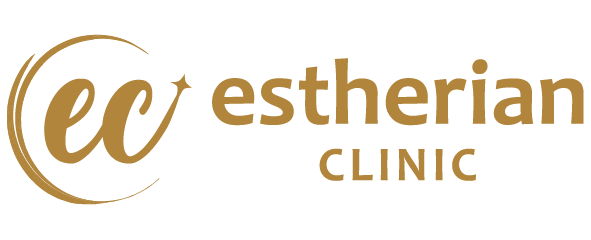Are you struggling with patchy beard growth or unable to grow a full beard due to genetics? A beard transplant in Turkey offers the perfect solution to achieve the masculine, dense beard you’ve always wanted. Turkey is a global leader in hair restoration, including beard transplants. Dr. Cengizhan Ekizceli and Dr. Mehmet Yıldıran at Estherian Clinic are known for their exceptional skills.
As graduates of Istanbul University Cerrahpaşa Medical Faculty, Turkey’s premier medical institution, our doctors bring unparalleled skill to every beard transplant procedure. Established in 2020, Estherian Clinic has quickly become a preferred destination for international patients seeking high-quality beard transplant procedures in Istanbul.
What is Beard Transplantation?
Beard transplant in Turkey is a great option for men who want a fuller, natural beard or to fill in gaps. Turkish clinics use advanced methods like DHI. This gives you precise and effective results for your desired style. With highly skilled surgeons and affordable prices, Turkey has become a top destination for beard restoration procedures. Start your journey to a confident, enhanced look today!
Beard transplantation is a special cosmetic procedure. It takes healthy hair follicles (grafts) from a donor area. This area is usually the back of the head. The follicles are then moved to parts of the face where beard growth is thin or missing. The procedure is used only in DHI (Direct Hair Implantation) for natural-looking results.
Whether you’re looking to:
- Fill in patchy areas
- Create a fuller beard
- Cover scars or burns on your face
- Achieve a specific beard style
A beard transplant in Turkey can help you attain the desired facial hair density and appearance with long-lasting results.
Causes of Patchy or Sparse Beard Growth
Many men desire a full, thick beard, but not everyone is naturally able to grow one. Genetics is the most common factor behind patchy or sparse facial hair. If your father or grandfather had difficulty growing a beard, there is a high chance that you might face the same issue. Hormonal factors also play a significant role; testosterone and dihydrotestosterone (DHT) are critical for stimulating hair follicles in the beard area. Lower levels of these hormones can result in thin or uneven beard growth.
Age is another consideration. Younger men may experience incomplete beard development, as facial hair tends to thicken and fill in fully only in the mid-20s. Medical conditions, such as alopecia areata or other autoimmune disorders, can damage hair follicles, causing bald patches in the beard area. Nutritional deficiencies, stress, and certain medications can also affect hair growth, further contributing to sparse or patchy facial hair.
Understanding the cause of inadequate beard growth is crucial before opting for a beard transplant. While genetics or hormonal imbalances cannot be completely reversed, hair transplantation offers a permanent solution to fill in gaps, enhance density, and create a natural, symmetrical beard.
Techniques
The FUE Technique
Follicular Unit Extraction (FUE) is one of the most advanced and widely used hair transplant techniques today. The procedure begins by identifying healthy hair follicles, typically from the back or sides of the scalp, where hair growth is dense and naturally resistant to thinning. These follicles are carefully extracted one by one using specialized micro-punch tools, ensuring minimal trauma to the donor area.
Once harvested, the surgeon prepares the recipient area, the thinning or bald regions, by creating tiny channels or incisions at precise angles and directions to mimic natural hair growth patterns. The extracted follicles are then meticulously implanted into these channels, allowing each hair to integrate seamlessly with the surrounding hair. Because the procedure targets individual follicles rather than large sections of skin, FUE avoids the linear scarring commonly seen with older strip-harvest methods.
DHI Technique
The Direct Hair Implantation (DHI) method is an advanced hair transplant technique similar to FUE but with key differences. Only the donor area is trimmed, so most of the scalp hair remains intact. Using specialized micro-punch tools, healthy follicles are extracted and immediately implanted into thinning areas with Choi Implanter pens. This allows for precise control over the angle, depth, and direction of each graft, resulting in a natural look.
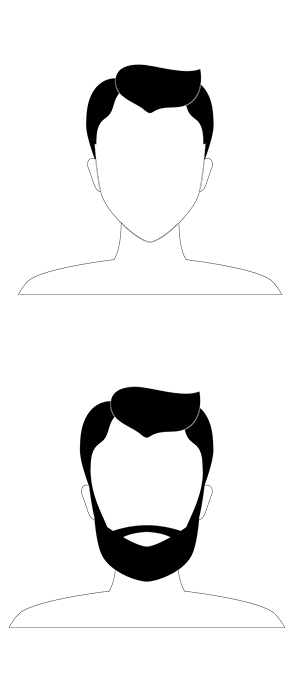
Why Choose Turkey for Your Beard Transplant?
- World-Renowned Expertise: Turkish surgeons are globally recognized for their skill in hair restoration procedures.
- Cost-Effectiveness: Significant cost savings without compromising on quality or results.
- Advanced Facilities: Clinics like Estherian feature state-of-the-art technology and adhere to international healthcare standards.
- Rich Cultural Experience: Combine your procedure with a visit to one of the world’s most fascinating cultural destinations.
- Convenient Location: Istanbul’s strategic position makes it easily accessible from Europe, Asia, and the Middle East.
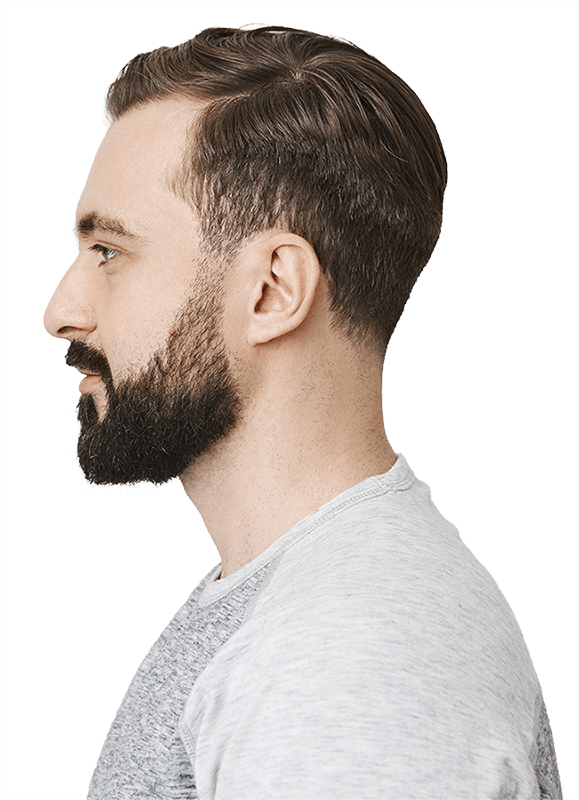
The Beard Transplant Procedure at Estherian
- Consultation and Planning: Our doctors look closely at your face, current beard pattern, and what you want. They will make a custom plan for your beard transplant.
- Donor Area Preparation: The donor area (usually the back of the head) is prepared for graft extraction.
- Graft Extraction: Using the advanced FUE method for the extraction of grafts.
- Canal Opening: Micro-incisions are created in the recipient area with precise angle and direction planning for natural growth.
- Graft Implantation: Hair follicles are meticulously placed into the prepared recipient areas by our experienced team.
- Post-Procedure Care: Comprehensive aftercare instructions and follow-up support ensure optimal healing and results.
The whole procedure is done with local anesthesia to keep you comfortable. It usually takes 4 to 8 hours, depending on how much transplantation is needed.
Beard transplant in Turkey pairs well with eyebrow transplant for comprehensive facial hair enhancement or hair transplant for overall hair restoration.
Who Is a Good Candidate for a Beard Transplant?
Ideal candidates for beard transplantation include:
- Men aged 22 and above
- Those with patchy beard growth due to genetics
- Individuals with facial scarring or burns
- Those who have experienced beard loss due to injury or trauma
During your consultation, our doctors will carefully evaluate several key factors to determine if you are a good candidate for a beard transplant. They will assess the quality and quantity of your donor hair, review your overall health to ensure the procedure is safe for you, and discuss your expectations along with the specific beard style you wish to achieve. This personalized evaluation allows the surgeon to design the most effective treatment plan and set realistic expectations for the outcome.
Benefits of Hair Transplantation
Hair transplantation offers both aesthetic and psychological advantages. Beyond simply restoring hair, it can significantly improve self-confidence and overall quality of life. Here are the main benefits:
1. Natural-Looking Results:
Both FUE and DHI methods use your own hair follicles, ensuring the transplanted hair grows naturally. When performed by an experienced surgeon, the results are virtually indistinguishable from your original hair.
2. Permanent Solution:
Unlike topical treatments or medications, transplanted hair is permanent. Once the follicles are successfully implanted, they continue to grow for a lifetime, reducing the need for ongoing hair loss treatments.
3. Minimally Invasive:
Modern techniques like FUE and DHI require only small incisions, resulting in minimal scarring. There is no need for large sutures, and most patients return to normal activities within days.
4. Customizable Density:
Surgeons calculate hair density per square centimeter to achieve a natural, balanced look. This allows precise placement of follicles to match your desired thickness and style.
5. Boosted Confidence:
Hair loss can impact self-esteem. Restoring hair can enhance personal and professional confidence, allowing individuals to feel more youthful and attractive.
6. Versatility:
Hair transplants are not limited to the scalp. Techniques like FUE and DHI can also restore eyebrows, beards, and even chest hair, offering comprehensive solutions for hair restoration.
7. Minimal Maintenance:
Once the transplanted hair grows, it can be treated like normal hair. There is no need for special shampoos or ongoing maintenance beyond standard hair care routines.
8. Long-Term Cost Efficiency:
While the initial cost can be higher than that of temporary solutions, hair transplantation eliminates the recurring expenses of hair products, medications, or temporary hairpieces.
Risks of Hair Transplantation
Like any surgical procedure, hair transplantation carries some risks. However, when performed by a skilled surgeon, complications are usually minimal and manageable. Understanding the potential risks helps set realistic expectations and ensures proper post-operative care.
1. Infection:
Although rare, infections can occur at the donor or recipient sites. Surgeons take strict sterilization precautions, and post-operative antibiotics are sometimes prescribed to minimize this risk.
2. Bleeding and Swelling:
Some bleeding may occur during or after the procedure, usually minor. Swelling around the scalp, forehead, or eyes is common and typically subsides within a few days.
3. Temporary Numbness or Tingling:
Patients may experience mild numbness or tingling at the donor or recipient sites. This usually resolves within a few weeks as the nerves heal.
4. Scarring:
FUE and DHI are designed to minimize visible scarring. FUE leaves tiny dot-like marks that are almost imperceptible, while DHI can further reduce the appearance of scars due to its direct implantation technique.
5. Follicle Shock Loss:
Sometimes, existing hair near the transplant site may fall out temporarily due to trauma from surgery. This is usually temporary, with regrowth occurring within a few months.
6. Asymmetry or Uneven Growth:
If follicles are not evenly distributed, hair density may appear uneven. Choosing an experienced surgeon significantly reduces this risk.
7. Poor Graft Survival:
A small percentage of transplanted follicles may fail to grow, which can affect the overall density. Proper surgical technique and post-op care help maximize graft survival.
8. Itching or Discomfort:
Itching is common as the scalp heals, but scratching should be avoided to prevent infection or damage to the grafts. Pain and discomfort are usually mild and manageable with prescribed medications.
9. Unnatural Appearance:
Improperly angled or placed follicles can result in an unnatural look. Skilled surgeons carefully plan follicle placement, angle, and density to create natural hairlines and a realistic overall appearance.
10. Rare Complications:
In very rare cases, patients may experience cyst formation at the transplant site or allergic reactions to anesthesia. These are uncommon and typically resolve with appropriate treatment.
Hair transplantation is considered very safe when performed in a reputable clinic by an experienced team. Following all pre- and post-operative instructions, including scalp care and avoiding smoking or alcohol, is key to minimising risks and achieving optimal results.
Why Estherian Clinic Stands Out for Beard Transplants
Choosing Estherian for your beard transplant in Turkey offers several distinct advantages:
- Doctor-Founded Clinic: Estherian was founded by Dr. Cengizhan Ekizceli, ensuring medical excellence is at the core of our practice.
- Experienced Medical Team: Our doctors perform 1-3 procedures daily, developing exceptional expertise in facial hair transplantation.
- Coordinated Care: Our 100+ member team works in perfect harmony, allowing our doctors to focus exclusively on the planning and surgical aspects of your procedure.
- Comprehensive Services: From hotel accommodations and transfers to interpretation services, everything is handled in-house by the Estherian family.
- Advanced Techniques: We utilise the latest DHI method for more precise, less invasive, and more natural-looking results.
- Lower Complication Rates: Our meticulous approach and dedicated post-operative care significantly reduce the risk of complications.
Recovery and Results After Beard Transplant
Following your beard transplant at Estherian Clinic, you can expect:
- Initial Recovery: Most patients can resume normal activities within a few days.
- Temporary Shedding: The transplanted hair may shed within 2-3 weeks, which is a normal part of the process.
- New Growth: New beard hair begins to grow from the transplanted follicles after approximately 3 months.
- Final Results: You will see the full results of your beard transplant in 6-12 months. Your new facial hair will look dense and natural. You can trim, style, and care for it just like a real beard.
Our team gives clear aftercare instructions. We are also available for remote follow-up. This helps ensure the best results and addresses any concerns during recovery.
FAQs About Beard Transplant
Is a Beard Transplant Permanent?
Beard transplants are considered permanent since the transplanted hair follicles continue to grow in the new area for a lifetime.
Does a Beard Transplant Look Natural?
Modern technique DHI ensures a natural look by carefully placing each follicle at the correct angle and density.
What is the Cost of a Beard Transplant in Turkey
One of the most compelling reasons international patients choose Turkey for beard transplants is the exceptional value. Beard transplant costs in Turkey are much lower than in Western Europe and North America. They also use the best care and modern techniques.
The cost of a beard transplant in Turkey typically ranges from €1,600 to €3,200, depending on factors such as:
- The number of grafts required
- The specific technique used
- The clinic’s location and reputation
- The complexity of the procedure
This represents savings of up to 80% compared to prices in the UK, US, and other Western countries, where the same procedure can cost between €7,000 and €9,000.
During your consultation at Estherian Clinic, our doctors will carefully evaluate the quality and quantity of your donor hair, your overall health, and your expectations regarding beard style to ensure you are a suitable candidate and to set realistic goals for your results. To make your journey as smooth as possible, we provide transparent, all-inclusive packages that cover every stage of the process, from the beard transplant procedure itself, medications, and anesthesia, to comfortable accommodation, airport transfers, translation services, and dedicated post-operative care. This way, you can focus fully on your transformation while we handle all the details.
Can I Choose the Shape of My Beard?
Yes, the surgeon works with you to design the desired beard shape, tailoring it to your face and preferences.
Can a Beard Transplant Be Combined with Other Procedures?
Yes, a beard transplant can be combined with other procedures like hair transplantation for comprehensive facial hair restoration.
Turkey, particularly Istanbul, has emerged as a global hub for hair and beard transplantation for several compelling reasons:
Beard Transplant In Turkey Before And After
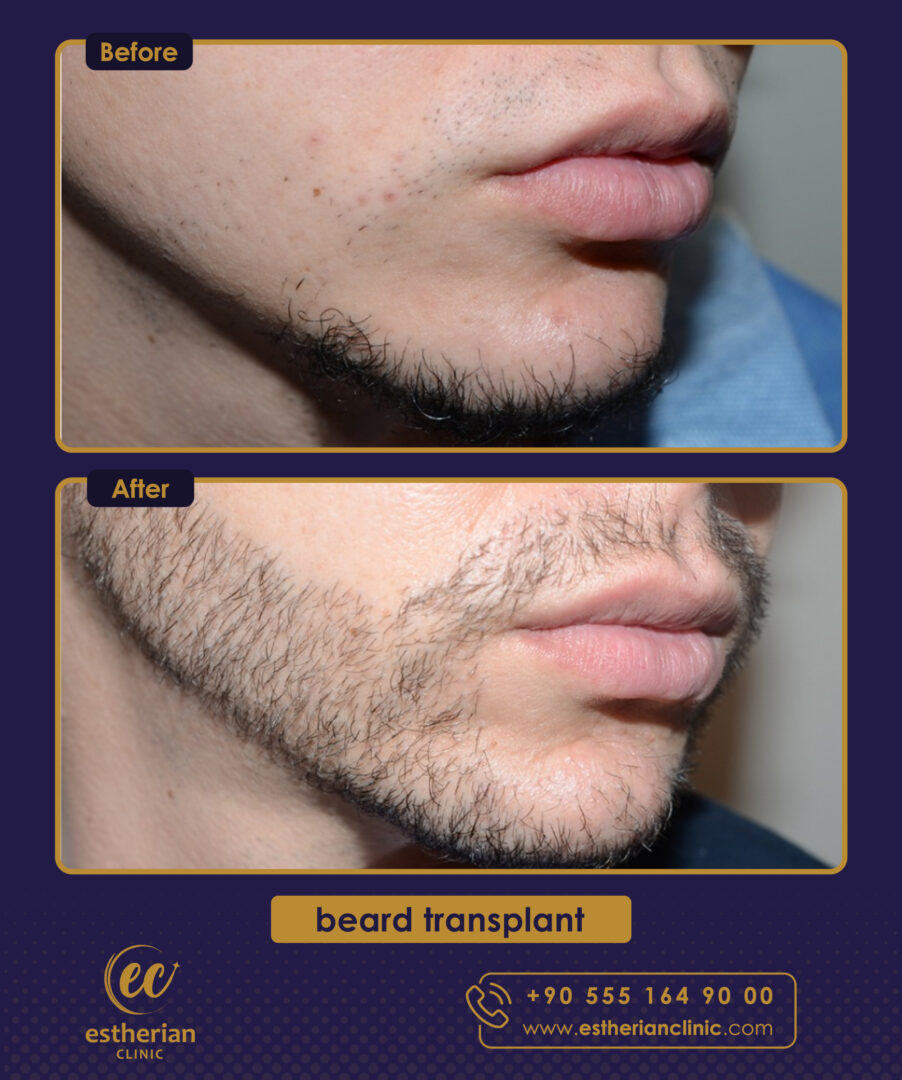
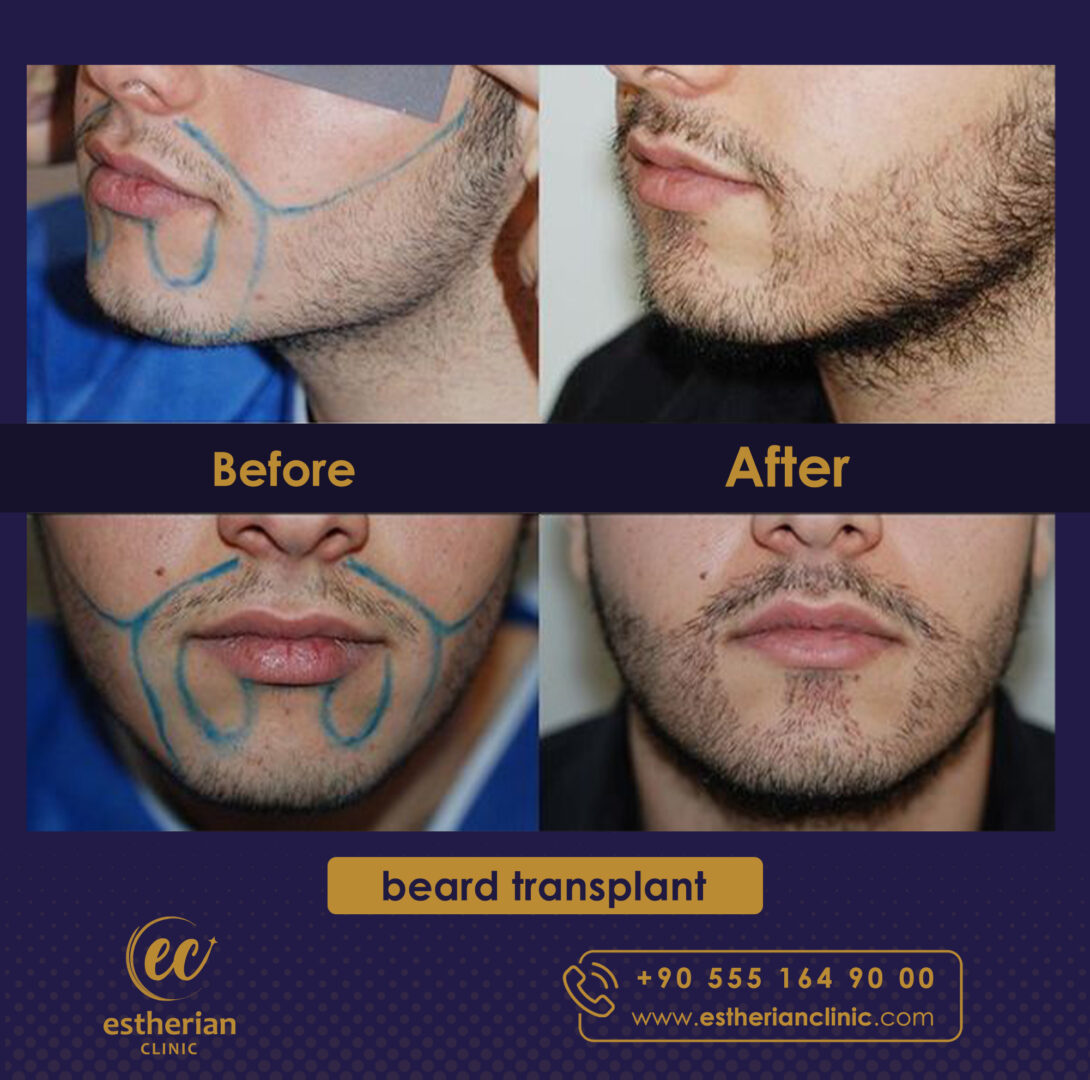

Related Articles About Beard Transplant
Plastic Surgery: Hair transplant surgery is performed to restore hair to areas of the scalp that are bald or that have thinning hair.
RealSelf: When it’s placed by a skilled hair transplant surgeon, transplanted hair will grow like beard hair and should look natural, even though it may show slight color differences.
Book Your Consultation Today
Transform your appearance and boost your confidence with a beard transplant at Estherian Clinic in Turkey. Contact us today to schedule your free consultation and take the first step toward achieving the full, natural-looking beard you’ve always wanted.
Remember, at Estherian Clinic, we don’t just transplant hair—we craft confidence and transform lives through our commitment to excellence in beard transplantation.
